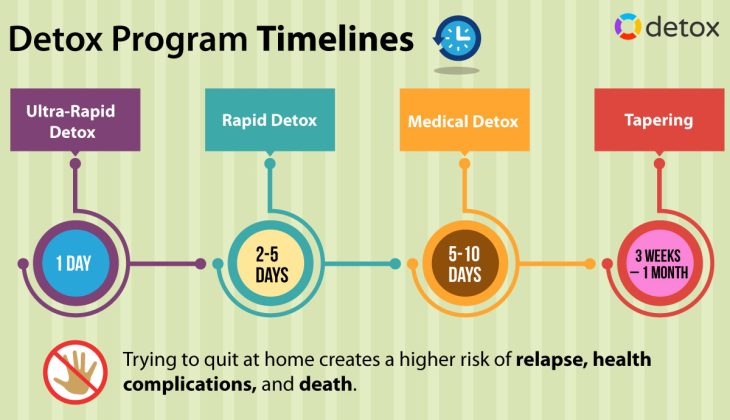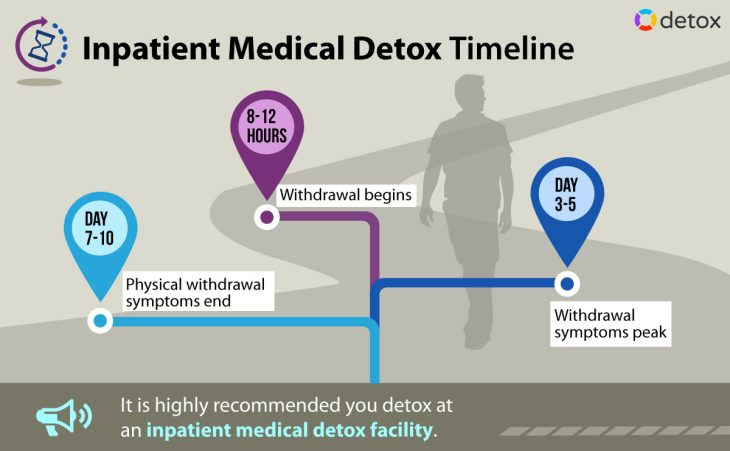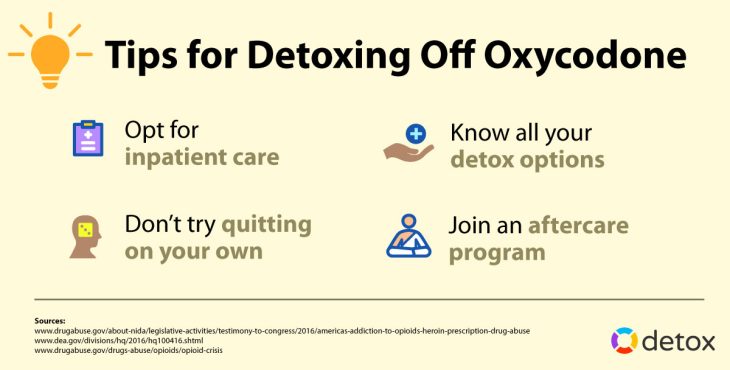How Long Does it Take to Detox from Oxycodone Withdrawal?
Oxycodone is an opioid medication commonly prescribed to treat moderate to severe pain. The strength of oxycodone is similar to that of morphine, and it produces effects of euphoria, pain relief, and extreme relaxation. But oxycodone carries a high risk for abuse, and it is one of the most common drugs involved in prescription opioid overdose deaths in the United States.
Because of its highly addictive nature, many people find quitting oxycodone on their own can be quite difficult. Oxycodone withdrawal symptoms, including opioid cravings, nausea, and vomiting, can be unpleasant and severe to the point that people resume their use of oxycodone just to relieve these symptoms. Quitting oxycodone on your own cold turkey or with an at-home detox kit often increases the risk for relapse, health complications, and death.
Professional oxycodone detox treatments are available to help people safely withdraw from oxycodone with a significantly lowered risk for serious health complications. But how long does oxycodone withdrawal last? Oxycodone detox can last as little as one to two days or as long as several weeks or months, depending on the detox method being used. Those who need oxycodone withdrawal help can choose a detox method that best meets their unique personal recovery needs and lifestyle.
Here’s a breakdown on how to detox from oxycodone, as well as the oxycodone withdrawal timeline for each detox method.

Oxycodone Detox Timeline
Withdrawal from oxycodone—how long does it last? The answer depends mainly on the detox method being used and on the severity of one’s addiction.
Here is the oxycodone withdrawal timeline for each detox method.
Rapid Detox
Rapid detox treatments last between two and five days, while ultra-rapid detox treatments typically last one day. With rapid detox, patients are put under general anesthesia and intravenously administered medications that accelerate the oxycodone withdrawal process. This allows patients to recover from oxycodone dependence as quickly as possible without experiencing pain and discomfort triggered by certain oxy detox symptoms.
Tapering / Medication-Assisted Treatment
Oxycodone detox is commonly conducted using either a tapering method or medication-assisted treatment, also known as MAT. Tapering is when a doctor reduces a patient’s oxycodone doses gradually over time to prevent withdrawal symptoms and to lower the risk for relapse and other health complications. MAT is similar to tapering, but replaces oxycodone with medications that mimic the effects of oxycodone and carry a far lower risk for addiction.
Tapering and MAT can last up to several weeks or months, based on the doctor’s tapering schedule. In most cases, those dependent on high doses of oxycodone often take the longest to detox from oxycodone using tapering and MAT.
MAT can help you overcome drug abuse for good. Get the treatment you need today!
Medical Detox
A medical detox from oxycodone generally lasts between five and 10 days. With medical detox, patients withdraw and recover from oxycodone at their bodies’ own natural pace, but they are monitored 24/7 by medical staff to reduce the risk for complications. In most cases, patients who undergo medical detox are prescribed medications that reduce and relieve oxy detox symptoms so they can recover more comfortably.
Medical detox timeline for oxycodone:
- Days one to three: Oxycodone withdrawal symptoms usually begin within eight to 12 hours of the last dose. Symptoms begin as mild, typically peak on day three, and may include sweating, runny nose and eyes, and sleep disturbances.
- Days three to five: Withdrawal symptoms are at their most severe on days three to five and may include abdominal cramping, diarrhea, and vomiting. Psychological symptoms of anxiety and depression may also present themselves during this phase.
- Days five through 10: Oxycodone withdrawal symptoms usually go away by day seven, but they can last for up to 10 days in those dependent on high doses of oxycodone. For some individuals, drug cravings and psychological symptoms of anxiety, depression, and agitation may persist for up to several days, weeks, or months after completing detox.
How to Detox from Oxycodone
Withdrawal symptoms from oxycodone and other painkillers are often more severe than those caused by other drugs due to the way opioids interfere with the brain and body. People who go through oxycodone detox are usually most concerned about withdrawal and about how to ease withdrawal symptoms from oxycodone in a way that allows them to completely avoid pain and discomfort.

Today, many oxycodone detox centers place emphasis on this concern of reducing pain and discomfort for patients. A pain-free approach lowers the risk for relapse and helps make recovery easier, bearable, and more comfortable for those dependent on the drug.
Here are tips to help you get started on oxycodone detox.
Opt for Inpatient Care
Inpatient detox centers are often most ideal for oxycodone patients, since these facilities offer 24/7 medical care and recovery support. Inpatient care allows patients to live on-site during detox so they can be closely monitored and prescribed medications as needed to reduce symptoms. Most inpatient detox facilities also offer psychological therapies to help patients overcome underlying causes of addiction after they complete their detox programs.
Toll-free
800-671-4304
Call Now
Don’t Try Quitting on Your Own
Quitting oxycodone cold turkey, naturally, or with at-home detox kits can be dangerous and risky and increases the risk for health complications like seizures and dehydration. These detox methods may seem like effective ways to overcome oxycodone dependence, but they do very little to relieve withdrawal symptoms and help you stay drug-free.
Join an Aftercare Detox Program
Detox is highly effective at helping you overcome physical dependence on oxycodone, but it does not treat underlying psychological causes of oxycodone addiction. Aftercare detox programs offer therapies that help you overcome psychological addiction so you can lead a far healthier lifestyle after completing detox. Cognitive-behavioral therapy, support group therapy, relapse prevention training, and individual, group, and family counseling are examples of therapies commonly available with aftercare programs.
Know All Your Detox Options
Rapid detox and MAT are other detox methods that can benefit your recovery from oxycodone use disorder. MAT can be conducted in an inpatient or outpatient setting to accommodate patients with varying lifestyles. For instance, those who must continue going to work or school or who must stay home to raise their children can benefit from MAT in an outpatient setting, where they can take daily medications that reduce cravings and other oxycodone withdrawal symptoms.
Signs You Need a Detox from Oxycodone
Do you need oxycodone detox? Many who become dependent on oxycodone may not be aware of their dependence or that they need help in the form of professional detox treatment. Oxycodone dependence is often unintentional and can occur when people misuse their medications or are prescribed high doses for a long period of time.
You may need an oxycodone detox if you experience oxycodone withdrawal symptoms when quitting this painkiller or when reducing use. Withdrawal symptoms can range from mild to severe and may last for up to several days. Many who go through withdrawal from oxycodone by themselves return to using the drug to avoid pain and discomfort associated with withdrawal.
Contact Detox.com now to find oxycodone detox centers near you!
Oxycodone Withdrawal Symptoms
Common oxycodone withdrawal symptoms include:
- Tearing eyes
- Runny nose
- Sweating
- Shaking
- Tremors
- Nausea
- Vomiting
- Muscle and bone aches
- Insomnia
- Abdominal cramping
- Diarrhea
- Problems with concentration
- Anxiety
- Depression
- Irritability
- Agitation
- Suicidal thoughts
- Drug cravings
Signs of Oxycodone Dependence
Those who are physically dependent on oxycodone may modify their lifestyles and behaviors in favor of obtaining, using, and recovering from oxycodone use. For instance, a person may devote less time to favorite hobbies and spend more time with new friends who accept or encourage their painkiller abuse.
Signs you may be dependent on oxycodone:
- Thinking about oxycodone constantly throughout the day.
- Inability to reduce oxycodone use despite numerous attempts to quit.
- Withdrawing from close friends and family.
- Hiding oxycodone supply from others.
- Using oxycodone in secret.
- Spending less time on favorite hobbies, interests, and activities.
- Feelings of anxiety when unable to obtain more oxycodone.
- Increased tolerance — you may start using higher amounts to feel the drug’s effects.
- Doctor shopping (visiting multiple doctors to get multiple oxycodone prescriptions).
Signs of Oxycodone Overdose
Those dependent on oxycodone are at high risk for suffering an overdose — especially those who quit oxycodone for a period of time and then resume using the same doses after taking a break from the drug. You or your loved one may need oxycodone detox if overdose symptoms are present.
Common oxycodone overdose symptoms:
- Slowed or stopped breathing
- Slowed heartbeat
- Low blood pressure
- Constricted pupils
- Cold sweat
- Extreme fatigue and drowsiness
- Muscle weakness
- Bluish tint to lips and fingernails
- Loss of consciousness
- Coma
An oxycodone overdose can be fatal, but it may be reversed with an opioid overdose reversal drug called naloxone. First responders such as police and paramedics often carry naloxone, which can also be purchased from pharmacies without a prescription in some states. Those who overdose on oxycodone and who are revived using naloxone are often encouraged to seek professional help in the form of oxycodone detox.

Long-Term Side Effects of Oxycodone Abuse
Long-term oxycodone abuse increases the risk for dependence and addiction and can also lead to serious health problems later in life. Oxycodone works by binding to opioid receptors in the brain responsible for controlling feelings of pain and pleasure. Long-term use of oxycodone can interfere with normal organ function and trigger a range of physical and psychological health conditions that may require years of intensive healthcare treatment.
Oxycodone abuse can upset the body’s natural hormonal balance and cause low sex drive, fertility problems, and irregular menstrual cycles. Long-term use of oxycodone also weakens the immune system, which makes users more susceptible to illness and disease. Studies show that those who suffer drug dependence tend to have higher rates of HIV, AIDS, organ failure, and cancer.
Other long-term health effects associated with oxycodone use disorder include:
- Abnormal pain sensitivity
- Heart attack
- Heart failure
- Kidney failure
- Liver failure
- Respiratory failure
- Gastrointestinal problems
- Phantom pain
- Sleep apnea
- Seizures
- Mental health disorders (e.g., depression, anxiety)
Those who suffer from oxycodone use disorder can greatly reduce their risk for these long-term side effects by seeking detox treatment as soon as possible. With the proper medical treatment and care, oxycodone patients can reverse the effects of oxycodone abuse gradually over time as they become healthier and stay addiction-free.
If you or someone you love is addicted to oxycodone, understand that getting oxycodone withdrawal help now can potentially save your life or the life of your loved one. Call 800-996-6135 to learn more about nearby opioid detox centers. Take the first step toward recovery today.


